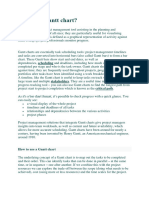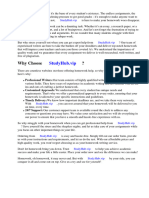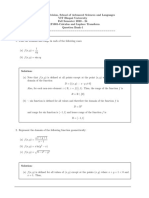0 ratings0% found this document useful (0 votes)
61 viewsGantt Chart-Basics
A Gantt chart is a bar chart that depicts a project schedule and is the most widely used chart in project management. It was designed by American mechanical engineer Henry Gantt in the early 20th century to help schedule and manage projects. A Gantt chart visually shows the tasks involved in a project along the vertical axis, while the horizontal axis represents the timeline with bars illustrating the start and end dates of each task. Gantt charts help project managers schedule, monitor, and communicate the progress of a project.
Uploaded by
41APayoshni ChaudhariCopyright
© © All Rights Reserved
Available Formats
Download as DOCX, PDF, TXT or read online on Scribd
0 ratings0% found this document useful (0 votes)
61 viewsGantt Chart-Basics
A Gantt chart is a bar chart that depicts a project schedule and is the most widely used chart in project management. It was designed by American mechanical engineer Henry Gantt in the early 20th century to help schedule and manage projects. A Gantt chart visually shows the tasks involved in a project along the vertical axis, while the horizontal axis represents the timeline with bars illustrating the start and end dates of each task. Gantt charts help project managers schedule, monitor, and communicate the progress of a project.
Uploaded by
41APayoshni ChaudhariCopyright
© © All Rights Reserved
Available Formats
Download as DOCX, PDF, TXT or read online on Scribd
You are on page 1/ 3
Gantt Charting: Definition, Benefits, and
How They're Used
What Is a Gantt Chart?
A Gantt chart is a commonly used graphical depiction of a project
schedule. It's a type of bar chart showing the start and finish dates of a
project's elements such as resources, planning, and dependencies.
Henry Gantt (1861-1919), an American mechanical engineer, designed the
Gantt chart.
KEY TAKEAWAYS
A Gantt chart is a visualization that helps in scheduling, managing,
and monitoring specific tasks and resources in a project.
It consists of a list of tasks and bars depicting each task's progress.
The horizontal bars of different lengths represent the project
timeline, which can include task sequences, duration, and the start
and end dates for each task
It's the most widely used chart in project management.
Gantt charts are used in heavy industries for projects like building
dams, bridges, and highways, as well as software development and
building out of other goods and services.
Understanding Gantt Charts
The Gantt chart is the most widely used chart in project management.
These charts are useful in planning a project and defining the sequence of
tasks that require completion. In most instances, the chart is displayed as
a horizontal bar chart.
Horizontal bars of different lengths represent the project timeline, which
can include task sequences, duration, and the start and end dates for each
task. The horizontal bar also shows how much of a task requires
completion.
The length of the bar is proportional to the time necessary for a task’s
completion. The project tasks are represented on the vertical axis.
A Gantt chart helps in scheduling, managing, and monitoring specific tasks
and resources in a project. The chart shows the project timeline, which
includes scheduled and completed work over a period of time. The Gantt
chart aids project managers in communicating project status and
completion rate of specific tasks within a project, and also helps ensure the
project remains on track. By convention, it is a standard tool that makes
communication unified among the engineering and project management
community.
Benefits of a Gantt Chart
The chart identifies tasks that may be executed in parallel and those that
can't be started or finished until others are complete. It can help
detect potential bottlenecks and identify tasks that may have been
excluded from the project timeline.
The chart depicts things like task slack time or additional time for
completion of a task that shouldn't delay the project; noncritical activities
that may be delayed; and critical activities that must be executed on time.
Gantt charts can be used in managing projects of all sizes and types.
These may include building infrastructures like dams, bridges, and
highways. They may also include software development and other
technologies. Project management tools, such as Microsoft Visio, Project,
SharePoint, and Excel, or specialized software, such as Gantto or
Matchware, can help in designing Gantt charts.
What Are Gantt Charts Used for?
Gantt charts help visualize various tasks and projects that occur
simultaneously within an organization, and how far along they have
progressed. They are used by management to plan and schedule such
projects so that resources can be allocated in an optimal way and that
projects that are prioritized can finish before less important ones begin.
Who Was Henry Gantt?
Henry Gantt was a social scientist and management consultant who also
held a degree in mechanical engineering. He worked in the field of
scientific management, developing methods to streamline and increase the
productivity of corporations and their workforce. He created the Gantt chart
in the 1910s to help supervisors understand the progress of their labor
force and to ensure tasks were on schedule.1
What Are the Components of a Gantt Chart?
A Gantt chart can vary in complexity and depth, but will always have three
key components: activities or tasks that are to be done, running along the
y-axis; milestones or progress stages indicated along the x-axis (either on
the top or bottom of the chart); and progress bars, denoted as horizontal
bars, denoting how far along each task is at any given point.
The Bottom Line
A Gantt chart is a visual description of a project's timeline. The chart
shows the start and end dates of a project's components, such as
resources and planning. If you are involved in a project, it is recommended
to use a Gantt chart to help organize the various tasks within the project.
You might also like
- Laboratory Studies in Integrated Principles of Zoology 18th EditionNo ratings yetLaboratory Studies in Integrated Principles of Zoology 18th Edition54 pages
- Problem Sheet - 1: Figure 1. Conduction Band Figure 2. Valance Band0% (1)Problem Sheet - 1: Figure 1. Conduction Band Figure 2. Valance Band2 pages
- Approaches To Understanding and Measuring Interdisciplinary Scientific Research (IDR) : A Review of The LiteratureNo ratings yetApproaches To Understanding and Measuring Interdisciplinary Scientific Research (IDR) : A Review of The Literature13 pages
- What Is A Gantt Chart - Gantt Chart Information, History and SoftwareNo ratings yetWhat Is A Gantt Chart - Gantt Chart Information, History and Software3 pages
- What Is A Gantt Chart? Gantt Chart Software, Information, and History What Is A Gantt Chart?No ratings yetWhat Is A Gantt Chart? Gantt Chart Software, Information, and History What Is A Gantt Chart?3 pages
- Engineering Management: Assist Proff. Layla L. AlwanNo ratings yetEngineering Management: Assist Proff. Layla L. Alwan5 pages
- Gantt Charts: Henry Laurence Gantt, An American Mechanical Engineer, Is Credited With The Invention of The Gantt ChartNo ratings yetGantt Charts: Henry Laurence Gantt, An American Mechanical Engineer, Is Credited With The Invention of The Gantt Chart10 pages
- Gantt Charts: Henry Laurence Gantt, An American Mechanical Engineer, Is Credited With The Invention of The Gantt ChartNo ratings yetGantt Charts: Henry Laurence Gantt, An American Mechanical Engineer, Is Credited With The Invention of The Gantt Chart10 pages
- Gantt Chart: "Gantt" Redirects Here. For Other Uses, See100% (2)Gantt Chart: "Gantt" Redirects Here. For Other Uses, See9 pages
- Gantt Charts: Henry Laurence Gantt, An American Mechanical Engineer, Is Credited With The Invention of The Gantt ChartNo ratings yetGantt Charts: Henry Laurence Gantt, An American Mechanical Engineer, Is Credited With The Invention of The Gantt Chart10 pages
- Gantt Chart A Gantt Chart Is A Bar Chart That Provides A Visual View of Project Tasks Scheduled Over Time. A Gantt Chart Is Used ForNo ratings yetGantt Chart A Gantt Chart Is A Bar Chart That Provides A Visual View of Project Tasks Scheduled Over Time. A Gantt Chart Is Used For4 pages
- Historical Development: Bar Chart Henry Gantt Project Schedule Project Work Breakdown Structure DependencyNo ratings yetHistorical Development: Bar Chart Henry Gantt Project Schedule Project Work Breakdown Structure Dependency1 page
- Gantt Chart - Wikipedia, The Free EncyclopediaNo ratings yetGantt Chart - Wikipedia, The Free Encyclopedia3 pages
- The 9 Essential Things in Your Gantt ChartNo ratings yetThe 9 Essential Things in Your Gantt Chart3 pages
- Using Gantt Chart To Kickstart A Project PDFNo ratings yetUsing Gantt Chart To Kickstart A Project PDF5 pages
- Gantt Charts Are Useful Tools For Planning of ProjectsNo ratings yetGantt Charts Are Useful Tools For Planning of Projects2 pages
- What Is A Gantt Chart: A Gantt Chart Lets You Communicate Your Project Timeline Visually in An Easy To Understand WayNo ratings yetWhat Is A Gantt Chart: A Gantt Chart Lets You Communicate Your Project Timeline Visually in An Easy To Understand Way5 pages
- Ebook - The Ultimate Gantt Chart Cheat SheetNo ratings yetEbook - The Ultimate Gantt Chart Cheat Sheet15 pages
- How to Visualize a Project: Complete Guide to Project Management and PlanningFrom EverandHow to Visualize a Project: Complete Guide to Project Management and PlanningNo ratings yet
- Research Project Management: 25 Free Tools: Evaluation Works’ Research Guides, #1From EverandResearch Project Management: 25 Free Tools: Evaluation Works’ Research Guides, #1No ratings yet
- Finasteride and Dutasteride For The Treatment of Male Androgenetic Alopecia A Review of Efficacy and Reproductive Adverse EffectsNo ratings yetFinasteride and Dutasteride For The Treatment of Male Androgenetic Alopecia A Review of Efficacy and Reproductive Adverse Effects19 pages
- Infection Prevention and Control (IPC) For COVID-19 VirusNo ratings yetInfection Prevention and Control (IPC) For COVID-19 Virus21 pages
- 2024 02 6 10 51 09 Statement - 1717305669606No ratings yet2024 02 6 10 51 09 Statement - 171730566960625 pages
- Attachment 2 GRD Request and Inquiry FormRIF 2No ratings yetAttachment 2 GRD Request and Inquiry FormRIF 22 pages
- 01- 24 MLD STP Bijnor Power Consume Report January-2025No ratings yet01- 24 MLD STP Bijnor Power Consume Report January-20251 page
- Search Warrant in Lehi City InvestigationNo ratings yetSearch Warrant in Lehi City Investigation8 pages
- Undersecretary: in View of The Preparations For The Upcoming School Year (SY) 2022-2023 School OpeningNo ratings yetUndersecretary: in View of The Preparations For The Upcoming School Year (SY) 2022-2023 School Opening2 pages
- Reflective Practice Using Assessment DataNo ratings yetReflective Practice Using Assessment Data58 pages
- 99.poultry Breeding and Multiplication Center OkNo ratings yet99.poultry Breeding and Multiplication Center Ok21 pages
- En Koodave Irum O Yesuve - Tamil Christian Song Keyboard Notation Notes PDF-Kve MusicNo ratings yetEn Koodave Irum O Yesuve - Tamil Christian Song Keyboard Notation Notes PDF-Kve Music1 page
- Lectures 1 - 10 Introduction To Classical Mechanics: Prof. N. Harnew University of Oxford MT 2016No ratings yetLectures 1 - 10 Introduction To Classical Mechanics: Prof. N. Harnew University of Oxford MT 2016102 pages

























































































